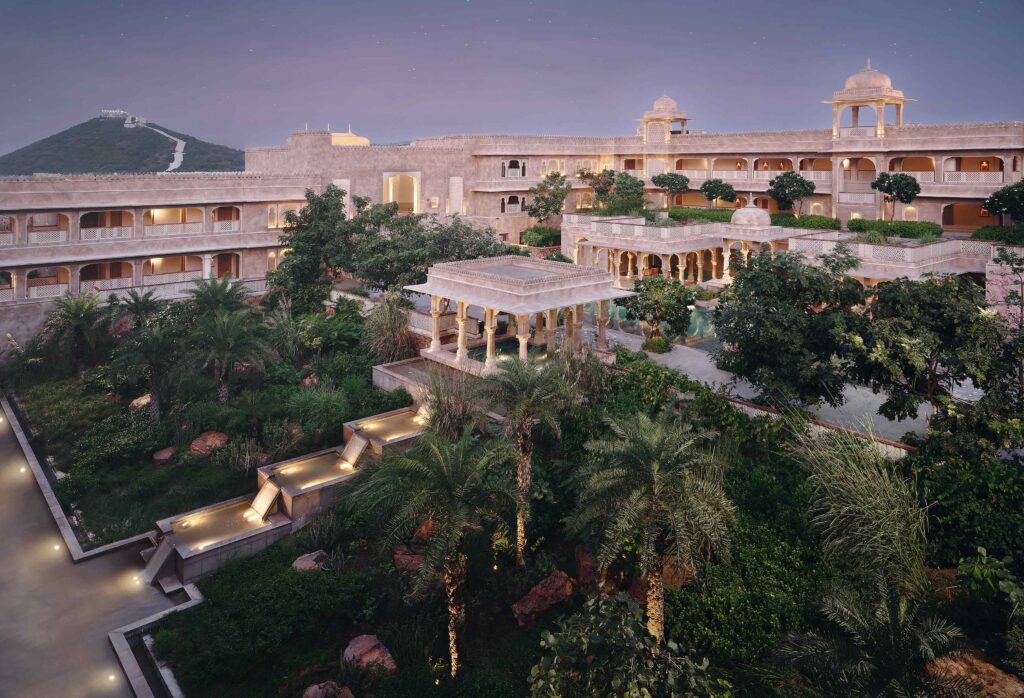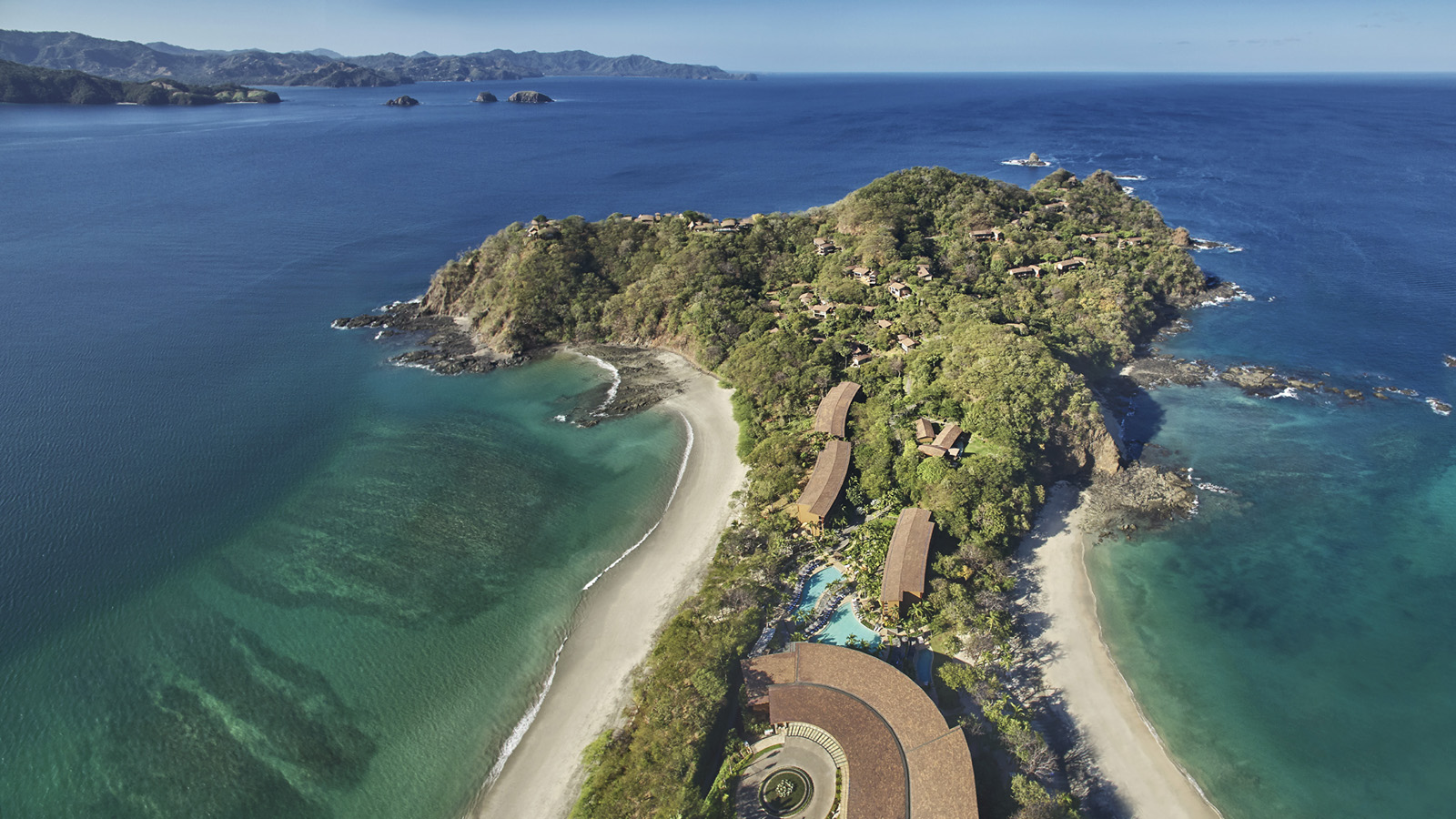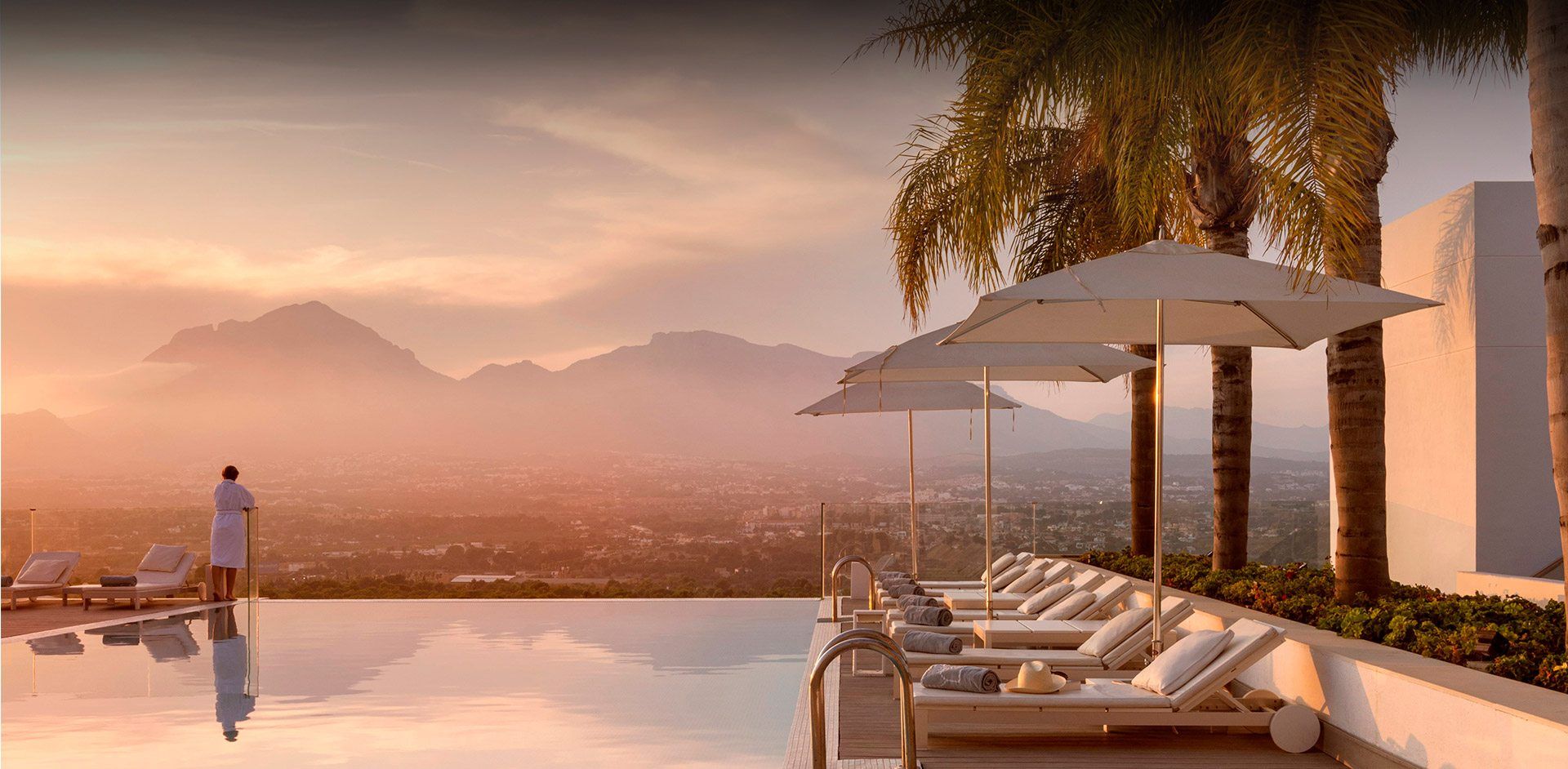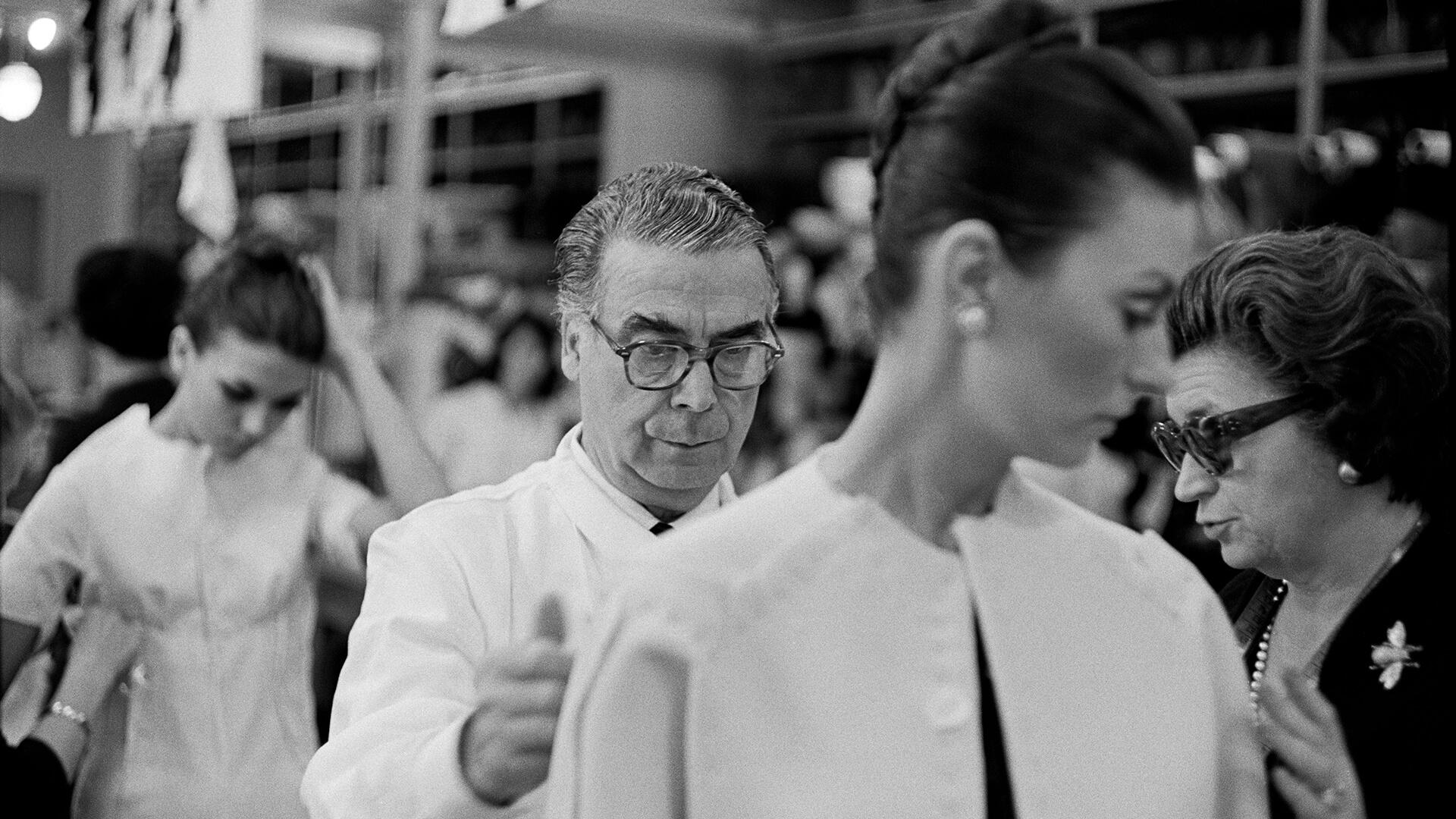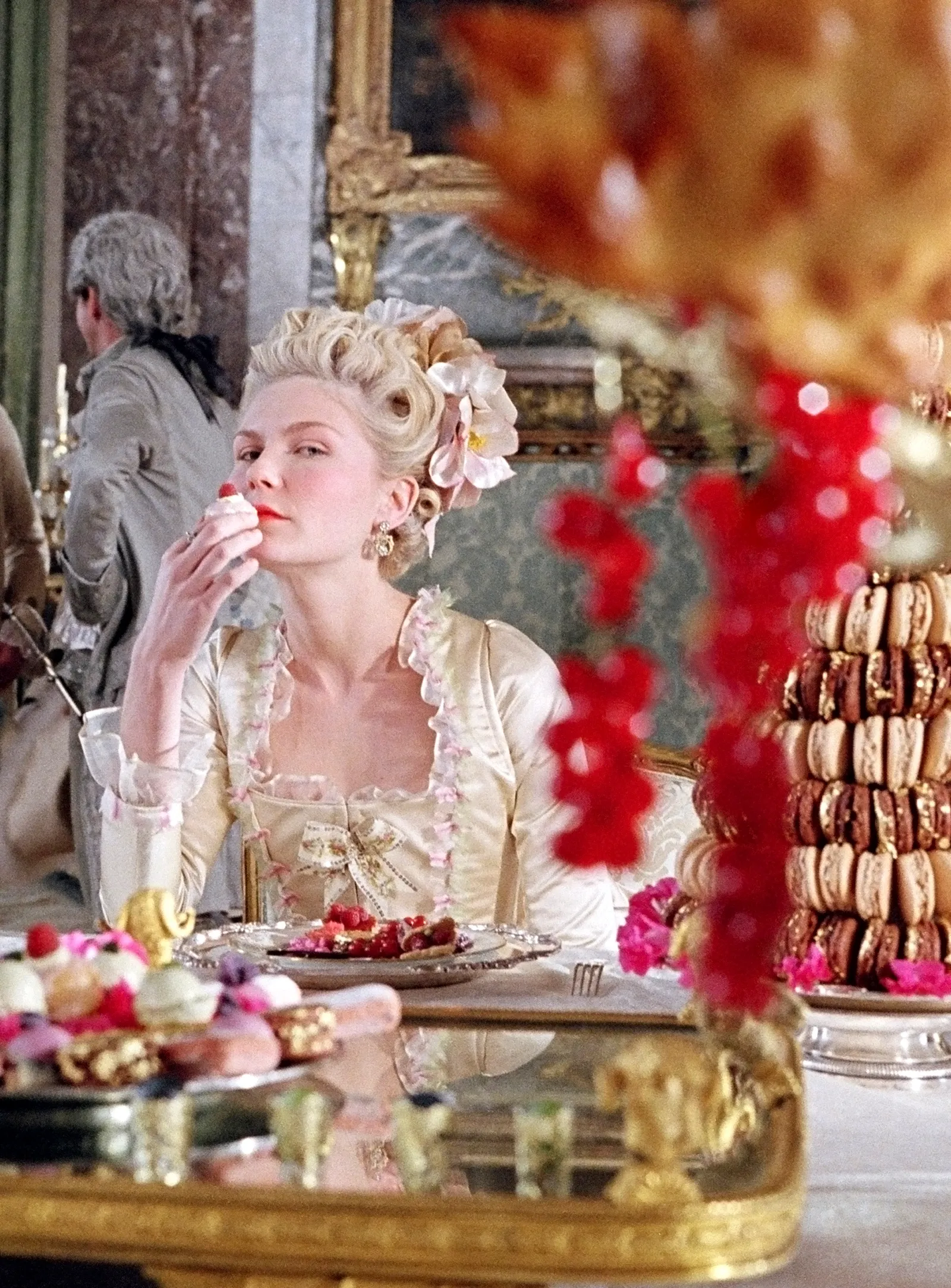In northwest India, Rajasthan is one of the destinations that may enchant kids the most with its palaces, peacocks, tigers, and jewelry.
Our six-year-old son Leo stated, “I’m excited about painting and elephants. These are the two main things I’m excited about in India.”
Though no one is quite sure where the idea for riding an elephant came from, Leo and his nine-year-old sister Stella are both art enthusiasts and in the weeks before our spring break trip, my husband Dave and I had told them we’d be visiting a miniature painting studio in Rajasthan. But somehow, by the time we set off last March, the elephants sat: kings of Leo’s imagination and at the top of his India to-do list.
Two images from India, one featuring a traveler taking a picture of a palace and the other featuring a window seat in a home
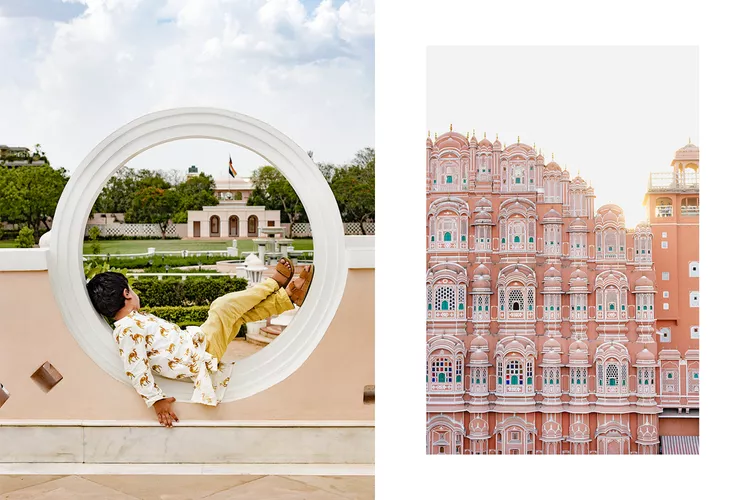
From left: An observer photographs the murals on Ganesh Pol, one of the entrances of Amber Fort, a serene nook of Ganesh Emporium, a clothing and art shop housed in an Old Town haveli in Udaipur. APARNA JAYAKUMAR
From an animal welfare standpoint, I didn’t dare to inform him that using elephants for tourist transportation isn’t considered a great or even particularly acceptable thing in 2023. Therefore, I secretly sighed with relief when, approximately five days into our trip, the four of us arrived at Amber Fort outside Jaipur and discovered that the sorry, chained-up herd that had once transported guests up to the 16th-century palace on the hill was nowhere to be found.
Leo, on the other hand, was discouraged. Our driver, Mr. Singh, an older man with a mustache and a beige uniform, sensed this, too, so he drove us up to the palace gates instead, where we all entered. There was a Hindu festival that day, and a crowd of worshippers had gathered around a temple in the central courtyard. A sermon echoed off the fortress walls over loudspeakers. A little further inside the complex, we stopped to snap a photo of the shimmering Sheesh Mahal, or Mirror Palace; close by, we discovered the hammam that had once been used by the fort’s founder, Maharaja Man Singh, as well as his restroom, much to the children’s unavoidable fascination.
When I was younger, my mother read a lot to me, and some of the books I can still clearly recall are about India. It wasn’t so much the characters or the stories that captivated my attention as the sensation of heat, light, and color that were so strong and foreign that they seemed to be from another planet.
We passed a puppet show and a snake charmer on our way back down to meet Singh, and by the time we were driving away from the palace, we had almost forgotten about the elephant ride until we saw a lumbering shape ahead of us. “Elephant!” Singh exclaimed, racing ahead of the animal and pulling onto the shoulder before we could say anything. He then leaped out and started yelling up at the two mahouts who were taking the resplendent animal—its face and ears painted in vibrant festival colors, its tusks adorned with gold rings—from the festivities at the fort back to the temple where it resided.
Two images from India: one of a woman having breakfast and the other of a red and white hotel guest room
From left: breakfast at Rajmahal Palace; a guest room at the boutique hotel Villa Palladio, just outside Jaipur. APARNA JAYAKUMAR
Stella and Leo paid a thousand rupees (roughly $12) and sat between the mahouts on the elephant’s back. At the same time, it lumbered along the road, tuk-tuks and Toyotas swerving and beeping, the sandy crenellations of Amber Fort receding into the background, and both kids’ faces lit up with astonished glee. It was magical and slightly wild, which sums up our trip to Rajasthan and the overall experience of traveling with kids in India.
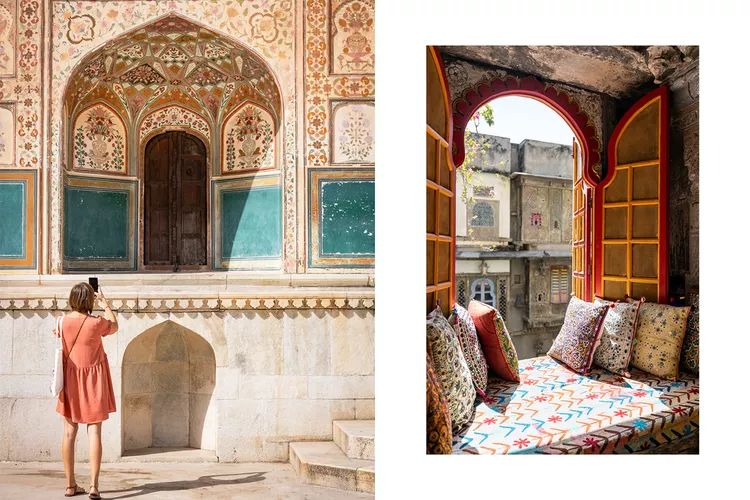
Growing up in the English countryside, I experienced extreme beauty and perpetually gloomy weather. My mother read a lot to me when I was younger, and some books I remember the most are about India. The books about India didn’t so much captivate my imagination with their stories or characters as with their intense and foreign color and heat that made them seem like they belonged on another planet. Was this a place where tigers, peacocks, intricate palaces, bejeweled saris, mangoes, and frangipani trees?
Two images from an Indian safari resort, one featuring a thali plate and the other showcasing design details
From left to right: Sher Bagh’s chicken thali and a campaign chair in a guest suite at Suján Sher Bagh. APARNA JAYAKUMAR
When I was eighteen, I decided to find out, and I embarked on a backpacking trip around India that was at least a rite of passage in the 1990s for British students. And while parts of the storybook picture did survive, I discovered a reality that was even more compelling, one that drew me back, this time with Dave by my side, to spend three years working in Mumbai. After that, we moved to New York City, and somehow, a decade passed before I realized it was time to return to India along with Stella and Leo.
Related: Reasons to Visit India on Your Next Safari
Not only does the subcontinent seem like a strange place to go on vacation because Dave and I have lived there, but the other parents we told about our trip responded in various ways, ranging from shock to outright horror. “Aren’t you worried they’ll get sick?” was one common question, and “How long is the flight again?” was another. Whether you fly into Mumbai or New Delhi, the journey from the United States is substantial; there’s no way to sugarcoat that, and the time difference is about as jet lag-inducing as it gets. However, if you choose the right tour operator and the suitable hotels, you will likely find yourselves more comfortable there than you would on a vacation back home.
Two images from India, one featuring jewelry that was on exhibit and the other featuring two sari-clad women peering out of a royal window
Views of Lake Pichola from the Zenana Mahal, or Palace of the Queens, which is a part of Udaipur’s City Palace; from left: A pink tourmaline and amethyst salad, or seven-strand necklace, on exhibit at Jaipur’s Gem Palace. APARNA JAYAKUMAR
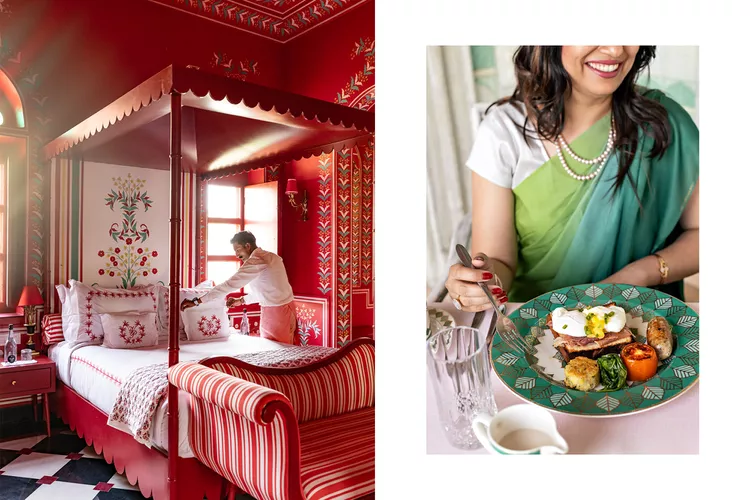
We booked our trip through a U.K.-based company called Wild Frontiers; its founder, Jonny Bealby, is passionate about traveling to less-traveled regions, especially India. He created a tour of Rajasthan that would include some of the most stunning hotels in the region and three of the northwest state’s most iconic locations: Jaipur, Udaipur, and Ranthambore National Park.
“The old heritage palaces give children this sense of wonder, this Disney-style experience. And Rajasthan, in particular, delivers all of that in real life,” Bealby remarked. “India is a fairy tale.”
So we set off from New York City, flying through one night and into the next and finally looking down, some 16 hours later, to see Mumbai’s cacophony of high-rises, palm trees, and blue tarp roofs rising through the midnight haze. As the kids dozed in the back of the taxi into town, I tried to make out familiar sights. But since my last visit, the city’s familiar layers of colonial, Art Deco, and contemporary architecture had been disrupted by a series of massive infrastructure projects (an entirely new subway system; 50 overpasses; a 14-mile coastal bridge), and some of my favorite parts of town were almost unrecognizable. I’d heard that India was modernizing at breakneck speed under the controversial leadership of Prime Minister Narendra Modi, and here was the evidence.
Two Indian images, one featuring a fort and the other featuring people walking on steps beside a lake
From left: the Rajput royal dynasty erected Amber Fort outside Jaipur in the sixteenth century; APARNA JAYAKUMAR splashed in Lake Pichola in Udaipur.
But there are certain things you can count on being the same, and as soon as we walked inside the South Mumbai Taj Mahal Palace hotel, we felt as comfortable as the cold, air-conditioned lobby and the aroma of freshly cut jasmine.
This leads to my first advice for long-distance family travel: try to stay the first night or two at a hotel you don’t need to leave. The Taj is probably the best example of this kind of hotel—it’s the city’s hub, with so much going on and a strong sense of place that you can spend the entire day there and still feel like you’ve experienced a typical Mumbai experience.
Related: Every year, my family takes a 15-hour flight to India; these ten things always make the trip easier
We slept until almost noon the next day. Although we were a little lost and strange when we woke up, we were greeted by the magnificent arch of the Gateway of India directly beneath our window, black-and-yellow taxis beetling along Apollo Bunder, the road in front of the hotel, and pigeons flying in formation over the shimmering Arabian Sea behind them.
After breakfast, which had ended hours earlier, we headed directly to the Taj’s garden filled with palm trees. Dave and I sipped coffee to calm our racing minds while the kids enjoyed the first of many mango lassis before jumping into the swimming pool.
Six Senses Fort Barwara’s pool
Six Senses Fort Barwara’s main pool. APARNA JAYAKUMAR
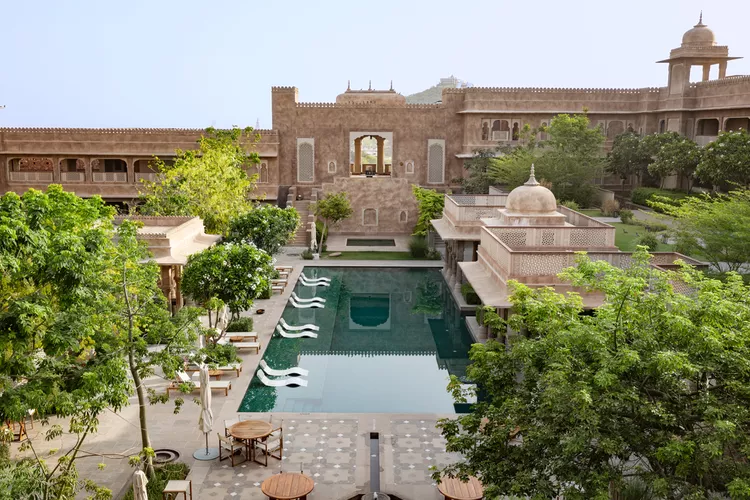
We ventured into the city late afternoon when we embarked on an e-carriage tour around south Mumbai. Battery-powered replicas of the Victorias introduced a few years ago after the long-suffering horses that transported tourists through the chaotic streets were outlawed come equipped with a hilarious array of equestrian sound effects. Stella and Leo were enthralled as we neighed and clip-clopped past the evening crowds on Marine Drive and in front of the wonderfully Gothic Chhatrapati Shivaji Terminus, which looked like Caesars Palace in the dusk.
Before returning to the Taj, we decided to get the kids some weather-appropriate clothing (we went in March when the average high was in the low nineties). Leo selected a set of block-printed pajamas from Fabindia, a cotton emporium in the Kala Ghoda district; Stella selected a full-length skirt adorned with mirror work called a lehenga, a pink sari blouse, and a matching dupatta, or scarf.
Two images from Jaipur, one featuring a server at a restaurant and the other showcasing the vibrant decor of a café
From left: APARNA JAYAKUMAR serves breakfast at Villa Palladio, located outside Jaipur in a peaceful area called Bar Palladio.
When we returned to our room, she changed into her princess attire, spinning about in front of the mirror and enquiring whether she may wear it again tomorrow.
We flew from Mumbai to Udaipur, which was once the capital of the Mewar kingdom and one of the wealthiest princely states of Rajasthan. In Udaipur, we met Singh, our driver, who drove us from the airport to a jetty on Lake Pichola, from where we took a boat to our hotel, Oberoi Udaivilas. Dave and I had visited Udaipur previously. However, as we set out across the water that day, with the Aravalli Hills sloping away on all sides and palaces casting dramatic shadows from the shore, it felt like we were entering a novel again.
Nestled between vibrant bougainvillea and hibiscus flowers, peacocks pose beautifully against picture-perfect vistas of the lake.
And then we reached the Udaivilas. We may still be processing the welcome there, but let’s say there was a camel involved, a shower of rose petals, and a troupe of dancers accompanied by a brass band in dazzling, rainbow-colored costumes. Stella looked stunning in her Fabindia lehenga and blouse, and she quickly became proficient in the steps and hand motions required for the dance.
Two images from the Six Senses Fort Barwara, one featuring the outside of the fort and the other an outdoor dining area
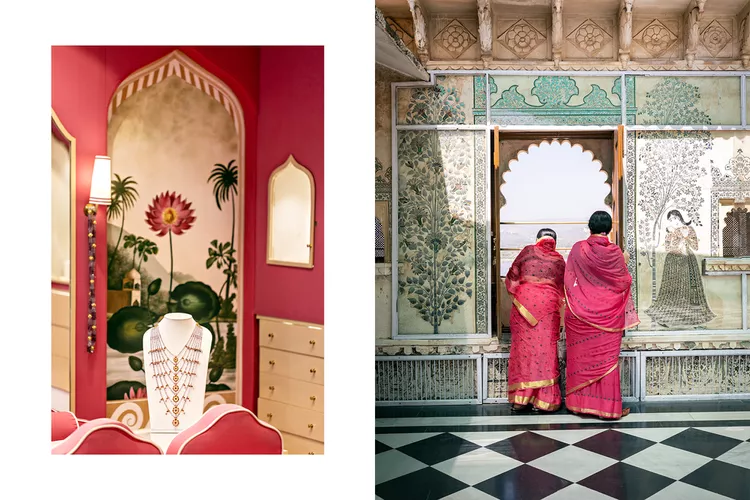
From left to right: A sitting space within a room at Six Senses Fort Barwara; an outlook of Muskmelon Palace, also known as Kharbuja Mahal, one of the original 14th-century buildings around the complex. APARNA JAYAKUMAR
The rest of the day was spent at the Udaivilas, basking in the beauty of it all. Situated on 30 acres along the shore of Lake Pichola, the property was once the hunting ground of the Maharana, or king, of Mewar and is now a sprawling hotel garden. Unlike many of Rajasthan’s iconic hotels, the Udaivilas is relatively new, having opened in 2002; its design, however, is unabashedly regal, with P.R.S. Oberoi, the company’s chairman at the time, declaring, “We are building a palace.” Mewari-style domes and cupolas are reflected in vividly tiled pools, mirrored mosaics shimmer away from the walls, and peacocks are arranged decoratively amid bougainvillea and hibiscus flowers against postcard views of the lake.
Additional Travel Inspiration: Travel + Leisure Readers’ Top 5 Indian Resorts for 2023
The following day, reluctant as we were to leave the grounds, it was time to try our hand at miniature painting. Singh took us to a shop called Shyam Arts, where a master miniaturist called Deepak Sharma was sitting on the floor of a second-floor studio, cross-legged, with two small paintings on a low table in front of him, both of which depicted a couple dancing on lotus flowers, so minutely detailed that we could barely make out the (invisible) brush strokes. The owner, Hemendra Pujari, explained that each picture would take the painter over a month to complete.
Pujari held out a brush for the children to examine, explaining that squirrel fur is preferred due to its softness. However, as adherents of Jainism, which forbids harming any living creature, the artists go to great lengths to obtain their bristles humanely, gradually taming wild squirrels with peanuts before “giving them a haircut.”
Two images from India, one featuring a little artwork and the other an antique automobile
From left: Maharaja Man “Jai” Singh’s 1950s Ford Thunderbird at Rajmahal Palace; a miniature painting at Shyam Arts, Udaipur workshop. APARNA JAYAKUMAR

Subsequently, Pujari demonstrated to the children how the miniaturists create their paints. “We search for the stones and we bring them home,” he said, taking a small rock from a bowl and identifying it as sulfur after dipping it in water and rubbing it against a tile to reveal a beautiful yellow color. Next, red oxide was used to create orange, zinc was used to create white, and graphite was used to create black.
The children guessed at different things, mostly involving plants and flowers. “Stella, can you guess what this yellow paint comes from?” Pujari asked, eliciting a chorus of screams and giggles. “This recipe was kept secret for generations, especially from girls, who would pass along secrets to other families when they got married.”
While the children practiced painting miniature versions of elephants, camels, and horses, Sharma prepared paper and a standard set of paints. Dave and I sipped masala chai from porcelain cups and browsed the store’s treasure trove of new and antique miniatures, having to control our impulse purchases once more on this trip.
Two images from India, one featuring a hotel room and the other a woman strolling by a pink palace
An outsider in Jaipur, India’s City Palace, a guest room at Six Senses Fort Barwara. APARNA JAYAKUMAR
When people talk about how easy it is to fall into a routine when on vacation—for example, “We quickly fell into a rhythm of mornings at the pool followed by afternoons at the beach”—that is not how India was. Every day, we did something so intense, so different, so unlike anything we could ever do at home, that when it came time to leave one hotel for another, we would all collapse into Singh’s car, relieved to have a few hours to ourselves.
Related: The World’s Top 9 Travel Expert-Selected Trips for Memorable Wildlife Encounters
But since this is India, those drives were an adventure in and of themselves. Our fearless pilot, Singh, skillfully avoided the obligatory cows on the road. We wound our way around camel carts driven by men wearing brightly colored turbans, herds of rugged-looking sheep and goats, and tractors carrying loads of hay so enormous that nobody was even slightly surprised when we passed several that had spilled all over the highway.
Our next destination was Jaipur, also known as the Pink City, established in 1727 by Maharaja Jai Singh II. (The capital was founded at Amber Fort, where the children rode the elephant, but it was moved to its current location after a few centuries.) Although the city is as busy and loud as any other Asian city, there are traces of its royal past all over the place, and the Old City is one of the most atmospheric locations in India.
Two images from Ranthambore National Park, one featuring a safari vehicle and the other a deer
From left to right: Suján Sher Bagh on safari in Ranthambore National Park; spotted deer in the park. APARNA JAYAKUMAR
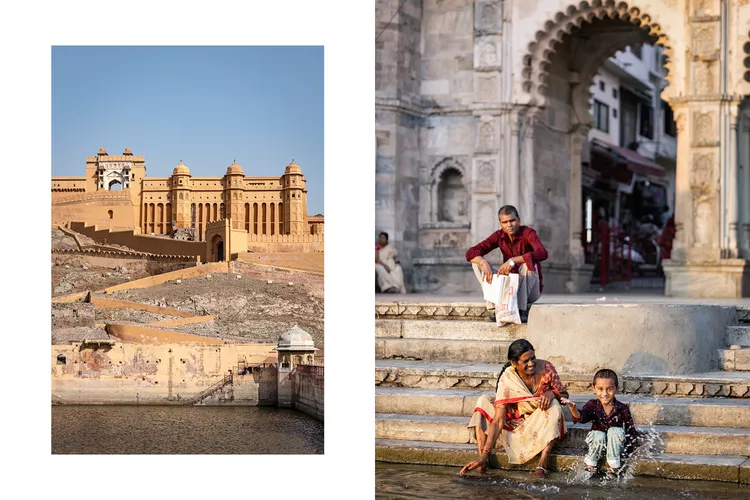
In Jaipur, a handsome young king named Padmanabh Singh recently came of age; his youthful, jet-setting profile feels like an expression of changes afoot across the city, where the tradition of craftsmanship established by Jai Singh II and his successors is today attracting a creative crowd from around the world. The maharajahs were dethroned soon after India became independent from Britain in 1947, but their families still command a high profile in Rajasthan.
We had seen vultures, parakeets, kingfishers soaring over a lake, and a crocodile lounging on a wall, but we had not spotted a tiger.
One of the best examples of this mix of old and new was our hotel, Rajmahal Palace RAAS. Originally the pink Art Deco mansion of Maharaja Sawai Man Singh and his glamorous wife, Maharani Gayatri Devi, it has been updated with modern, maximalist wallpapers and other excellent design touches, and its restaurant, 51 Shades of Pink, is a favorite lunch spot for the Jaipur in the crowd. It also features a charming pool surrounded by pink stucco walls and mango trees, where the four of us would cool off between excursions and sip fresh lime sodas while lounging around in our bathrobes, feeling like we were in a Wes Anderson movie.
Jaipur is a big shopping destination, so one afternoon, we took Stella and Leo on a retail tour, stopping at upscale boutiques and traditional bazaars. The kids opened drawer after drawer of jewels in abundant shapes and sizes at the Gem Palace’s shocking pink upstairs atelier. They tried on candy-colored pieces fashioned like frogs, birds, and muskmelons.
Two images from the Oberoi Udaibilas show a villa pool and a guy operating a ferry.
From left: The view from the Kohinoor Suite at the Oberoi Udaivilas; an Oberoi employee transports clients over Lake Pichola. APARNA JAYAKUMAR
Later, during a rummage through Johari Bazaar, the kids each selected a pair of jutti or embroidered slippers; Leo’s were excellent, with toes that curled all the way around in a manner reminiscent of Aladdin, and he insisted on wearing them straight out of the store. We all purchased matching pajamas at the flagship of Anokhi, the renowned block-printing label that brought Indian textiles to the West in the 1970s.
Ashish Sharma said, “Today, we are going full tigering,” while pumping his fist. Our guide at Ranthambore National Park, located in eastern Rajasthan, Sharma, told us about the park’s eighty big cats and how it’s one of the best sites to watch tigers in the wild. Undoubtedly, this aspect of the journey had been a significant selling point for Stella and Leo, and anticipation had been intense upon our arrival at Suján Sher Bagh the day before. The proprietors of the lodge, Jaisal and Anjali Singh, and Jaisal’s father, Tejbir before them, are regarded as pioneers in conservation tourism. The lodge was among the first to open in the vicinity of Ranthambore. Tucked away in the deciduous woods on their property are twelve tastefully designed rooms that resemble safari tents. Our accommodation, the family suite, consisted of two tents grouped around a swimming pool; within each was a four-poster bed screened from mosquitoes and a large brass bathtub.
Two images from Ranthambore National Park, one featuring a peacock and the other a route through a tree
At Ranthambore, the 14th-century fortress gate is home to a banyan tree that is reputed to be hundreds of years old. In Ranthambore, India’s national bird, the peacock displays its tail feathers.
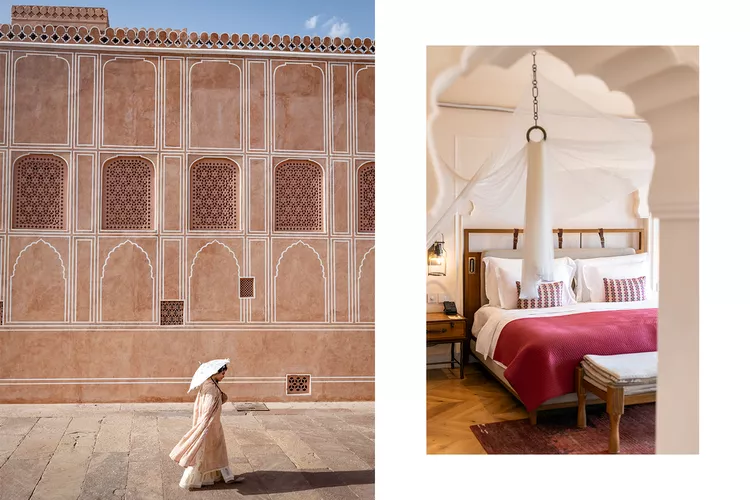
We had met Sharma and our driver at first light that morning, and we had gone on a game drive. We noted spotted sambar deer mon, gooses, and golden jackals in the little Field Books we had each discovered beside our mattresses. We had observed vultures, parakeets, kingfishers soaring over a lake, and a crocodile sunning itself on a wall. But had a tiger been spotted? We hadn’t.
When we were all back in the vehicle that afternoon, Sharma’s anxiousness was evident. If it came down to it, this would be our final safari, and if we saw a tiger, that was what we would do. There would be no pauses to snap pictures of intriguing trees or the picturesque 10th-century fortresses that sprout up among Ranthambore’s lakes and woods, nor would there be any opportunity to stop and observe birds or other less spectacular species. It was time to take things seriously as we were in full tigering mode.
A father and son make a splash in an Indian mansion pool.
Refreshing at Oberoi Udaivilas resort. JAYAKUMAR APARNA
We drove about for an hour or so, stumbling over rocks and rattling through the brush until, at last, we turned a corner and saw a line of jeeps stopped up, everyone aiming their iPhones, binoculars, and zoom lenses in the same direction. After stopping and nervously adjusting our binoculars, we managed to finally spot the shank of a juvenile male, his stripes providing an exceptionally excellent camouflage against the dark, thin trunks of the dark trees and the pale ocher dirt. The most important thing was that we had seen a tiger, even though it wasn’t quite the sighting of our dreams.
See also: 7 Family Vacations Everybody Ought to Take
A few minutes later, we pulled over and stopped for cookies and masala chai in the vehicle’s rear, to everybody’s amazement and relief. While eating, Sharma informed us that he was born in a hamlet that was moved to Ranthambore after the region was designated as a national park in 1981. “It was just jungle life back then—no electricity, no schools,” he remarked. While strolling in the jungle, Sharma and his father encountered a tiger one day. At this time, the youngsters stopped eating their snacks in mid-mouthful. “We hid behind a tree,” he added. “The tiger did not attack; it was aware of our presence. I was seven years and fifteen months old.
Overlooking the Six Senses Fort Barwara resort, birds soar.
At Six Senses Fort Barwara in the early morning. JAYAKUMAR APARNA
We all fell silent as we realized that, when Sharma was just a few months older than Leo, he had been within feet of an unarmed, unprotected wild tiger. I inquired about his village’s thoughts about departing from Ranthambore. Sharma said, “The old people didn’t want to leave the forest.” “However, the youth perceived the future.”
It was time for our last castle, which represented Rajasthan’s artistic character in the most modern way. Rising from a hamlet with a lake view, Six Senses Fort Barwara is a stunning blend of old and new, around an hour’s drive from Ranthambore. Three modest original buildings, the oldest of which is the 14th-century Kharbuja Mahal, also known as Muskmelon Palace, form its core. A massive new resort has been built in the vicinity of these, bursting with contemporary glitz and harmonious with the fort’s original design.
Related: These European Hidden Castles Look Like Something From a Fairytale
A high-profile Bollywood wedding happened at Fort Barwara shortly after it opened in 2021, and other visitors adopted the same attitude, hanging around the pool in fancy outfits with a Western flair, snapping phone photos, and behaving like Delhi-born Mumbaikars. The quirky doorknobs, room signage by the Jaipur studio ASA, and the chicly packaged local brands in the mini-bar added a trendy touch to the whole design.
Picture of a youngster eating pastries taken overhead.
Pastries from Six Senses Fort Barwara’s Cortile restaurant.
We went on a tour with the knowledgeable guide, Kunal Bhatt, since I was interested in learning more about the history of Fort Barwara. He clarified that the Chauhan dynasty governed these areas 700 years ago and was responsible for building the first palace. To prevent elephant intrusions, a later family erected enormous wooden gates that are currently utilized as the hotel’s rear entrance. The gates were studded with hundreds of sharp metal spikes.

We had a tour of the Shikar Bhuj, a tower formerly used to shoot tigers and now a restaurant. The female members of the royal family would reside in seclusion from the outside world at the Zenana Mahal, also known as the Palace of the Queens. Presently, the elaborate 30,000-square-foot building houses the Six Senses Spa.
As I watched the two tiny bodies next to me fidget and struggle to keep their eyes closed, I imagined they would only bring two things back from this trip: a feeling of wonder and perspective. Above everything, my greatest wish was that they would always have those items with them.
In this quiet, temple-like setting, Dave and I each had a much-needed 90 minutes of massage therapy from a very talented masseuse from Kerala. I ascended the 650 stairs to a local temple the following morning. A villager dressed in a white turban, a kurta (tunic), and dhoti (loincloth) then arrived to instruct the children in the art of throwing clay pots into a stone wheel that resembled a massive spinning top, which he drove into the ground and rotated with his hands.
Two images from India: one of pigeons in front of a vibrant painting and the other of a woman at a Udaipur market
From left: Pigeons at Gangaur Ghat, on the shore of Udaipur’s Lake Pichola; fruit vendors at a street market in Udaipur. JAYAKUMAR APARNA
In a pavilion atop the fort’s roof, we attended a family yoga session that evening as the sun started dropping. Our patient teacher, Rina Bharati, demonstrated many animals poses for Leo and Stella, including cats, cobras, and (downward-facing) dogs. She played a quartet of brass and crystal singing bowls, and we all sat cross-legged in sukhasana, or easy position, to close the class. Then the vibrations came, filling our pavilion with waves of mesmerizing music that appeared to reach far beyond the roofs and fields below.
I reflected on my first trip to Rajasthan as a traveler at the age of eighteen, reflecting on how much my life had changed and how much had changed in India. I reminisced about my youthful curiosity and lack of understanding of the world. As I watched the two tiny bodies next to me fidget and struggle to keep their eyes closed, I imagined they would only bring two things back from this trip: a feeling of wonder and perspective. Above everything, my greatest wish was that they would always have those items with them.
An Indian safari lodge’s family suite
The Suján Sher Bagh family suite has two tents grouped around an exclusive pool. JAYAKUMAR APARNA
Plan a Family Vacation to Rajasthan

Mumbai
Taj Mahal Palace: Although the original Taj Hotel boasts an unparalleled location, recognizable architecture, and more amenities than you could ever need, what makes it stand out is the atmosphere. For a low-impact approach to exploring the sites, ask the concierge to arrange an e-carriage tour of the city’s historic southern area. Doubles the $421 amount.
Fabindia: A must-visit for souvenirs and weather-appropriate apparel, this cotton emporium is located in the Kala Ghoda district.
Agra
The Oberoi Udaivilas is a consistent reader favorite, and for good reason—the lakeside location and architecture are breathtaking, and the service is exceptional.
The Leela Palace: We had a fantastic meal at the Sheesh Mahal restaurant, which offers a variety of traditional Indian fare and has a view of Lake Pichola.
The Ganesh Emporium is a townhome resembling a labyrinth filled with antique crafts, artwork, and fabrics. Vipul Shah, the founder’s son, operates a modern womenswear store upstairs that features traditional Rajasthani textiles.
Shahpura
Shahpura Bagh: This charming 11-room hideaway, formerly a royal palace, is ideal for taking a hiatus from the trip between Udaipur and Jaipur. The former Maharajah and his family now manage it.
Jaipur
Rajmahal Castle RAAS: Now a chic 13-room hotel, this pink Art Deco castle once housed generations of Jaipur nobility. When the British monarchy visited in 1961, we stayed in the QEII Suite.
Opened in 2022, Villa Palladio is a luxurious hotel on the city’s outskirts designed by the same Swiss-Dutch team that created Bar Palladio. The hotel has a cute red antique automobile that guests may use to get a lift into town.
Bar Palladio: This opulent restaurant and lounge in the Hotel Narain Niwas Palace grounds has become renowned on Instagram for its blue-and-white interior design, and the actual thing more than lives up to the hype.
The Johri: Located in the center of the bustling Johari Bazaar, this elegant five-room hotel features a restaurant serving seasonal, organic vegetarian fare and a picturesque martini bar.
Anokhi: There’s a reasonable probability that this innovative brand produced the Indian cotton outfit you’ve always envied. Shopping for apparel and home textiles is recommended at Anokhi’s main store in Jaipur.
The Gem Palace: This well-known jewelry business, which has been in the same family since 1852, is a must-see when visiting Jaipur. The bottom floor features traditional and antique artifacts, while the second-story atelier features more contemporary designs.
The Ranthambore
Suján Sher Bagh: This 12-suite safari-style resort, from which visitors may go tiger-spotting in the neighboring national park, has something about it. Samandar Singh, our butler, was among the friendliest, most accommodating employees I’ve ever met at a hotel.
Barwara Fort
Six Senses Fort Barwara: This resort, housed in a renovated 14th-century palace, made headlines in India and abroad when it opened in 2021. The 48 apartments are modern and fresh, and as this is a Six Senses property, the wellness offerings are exceptional. The scenery is reminiscent of something from a fairy tale.
Delhi
The Leela Palace New Delhi: This opulent hotel in the beautiful Chanakyapuri district is highly recommended if you want to fly into or out of the Indian capital. Even though the hotel is close to many of the city’s landmarks, its opulent guest rooms and faultless service make it feel like an oasis.
How to Make a Reservation
Wild Frontiers: This expert on India can assist in creating a personalized, family-friendly schedule that includes immersive activities like miniature painting in Udaipur.
This story originally ran under “I Dream of India” in the December 2023/January 2024 edition of Travel + Leisure.
Conclusion
- The family’s trip to Rajasthan, India, with their children offered a magical and unique experience filled with cultural immersion and unexpected adventures.
- The article highlights the blend of traditional and modern experiences, from visiting historic palaces and engaging in miniature painting to encountering elephants and exploring vibrant markets.
- The family booked their trip through Wild Frontiers, a U.K.-based company, and stayed at luxurious hotels like Taj Mahal Palace, Oberoi Udaivilas, Rajmahal Palace RAAS, Suján Sher Bagh, and Six Senses Fort Barwara.
- The travel itinerary included Mumbai, Agra, Shahpura, Jaipur, Ranthambore, and Delhi, showcasing the diverse attractions and rich heritage of Rajasthan, making it an ideal family vacation destination.

